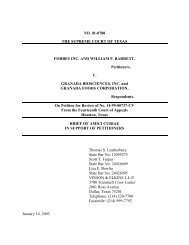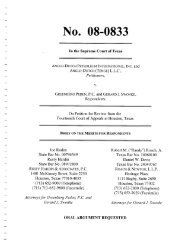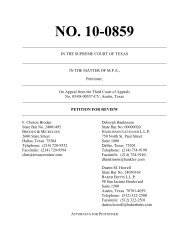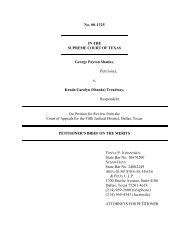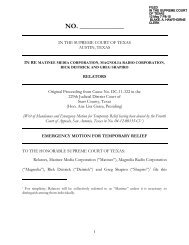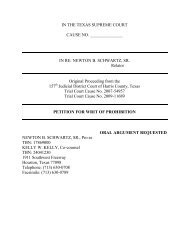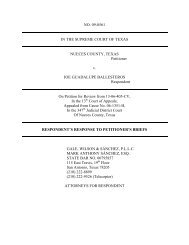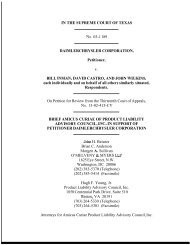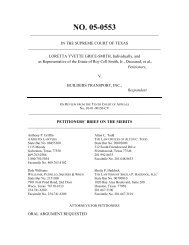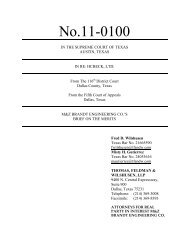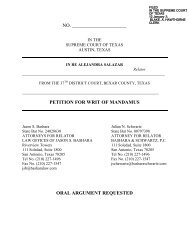Petition for Writ of Mandamus - Filed - Supreme Court of Texas
Petition for Writ of Mandamus - Filed - Supreme Court of Texas
Petition for Writ of Mandamus - Filed - Supreme Court of Texas
You also want an ePaper? Increase the reach of your titles
YUMPU automatically turns print PDFs into web optimized ePapers that Google loves.
An affiliated group can include:<br />
• pass-through entities, including partnerships;<br />
• limited liability companies taxed as partnerships under<br />
federal law;<br />
• S corporations; and<br />
• disregarded entities under federal law.<br />
A combined group cannot include:<br />
• taxable entities that conduct business outside the United<br />
States if 80% or more <strong>of</strong> the taxable entity's property and<br />
payroll are assigned to locations outside the United<br />
States;<br />
• insurance companies that pay the gross premium tax;<br />
• an entity exempt under Chapter 171, Subchapter B; or<br />
• passive entities; however, the pro rata share <strong>of</strong> net income<br />
from a passive entity shall be included in the total revenue<br />
to the extent it was not included in the margin <strong>of</strong> another<br />
taxable entity. (See the section on Passive Entities <strong>for</strong><br />
additional in<strong>for</strong>mation.)<br />
A unitary business is defined as a single economic enterprise<br />
that is made up <strong>of</strong> separate parts <strong>of</strong> a single entity or <strong>of</strong> a<br />
commonly controlled group <strong>of</strong> entities that are sufficiently<br />
interdependent, integrated and interrelated through their<br />
activities so as to provide a synergy and mutual benefit that<br />
produces a sharing or exchange <strong>of</strong> value among them and<br />
a significant flow <strong>of</strong> value to the separate parts. All affiliated<br />
entities are presumed to be engaged in a unitary business.<br />
See franchise tax Rule 3.590 <strong>for</strong> more detailed in<strong>for</strong>mation<br />
on combined reporting.<br />
Reporting Entity<br />
The combined group's choice <strong>of</strong> an entity that is:<br />
1) the parent entity, if it is a part <strong>of</strong> the combined group, or<br />
2) the entity that is included within the combined group, is<br />
subject to <strong>Texas</strong>' taxing jurisdiction, and has the greatest<br />
<strong>Texas</strong> business activity during the first period upon which<br />
the first combined group report is based, as measured<br />
by the <strong>Texas</strong> receipts after eliminations <strong>for</strong> that period.<br />
The reporting entity shall file a combined report on behalf<br />
<strong>of</strong> the group together with all reports and schedules required<br />
by the Comptroller. The reporting entity shall change only<br />
when the entity (other than the parent) is no longer subject<br />
to <strong>Texas</strong>' jurisdiction to tax or the reporting entity is no longer<br />
a member <strong>of</strong> the combined group.<br />
Combined Report<br />
A combined group shall include all taxable entities without<br />
regard to the $1,030,000 no tax due threshold on total<br />
revenue. For example, even if an entity in a combined group<br />
on its own has less than or equal to $1,030,000 in total<br />
revenue, that entity must still be included in the report <strong>for</strong> the<br />
combined group.<br />
Unless a combined group qualifies and chooses to file using<br />
the EZ computation, the combined group's margin is<br />
computed in one <strong>of</strong> the following ways:<br />
• Total Revenue times 70%<br />
• Total Revenue minus Cost <strong>of</strong> Goods Sold (COGS)**<br />
• Total Revenue minus Compensation<br />
"If eligible. See instructions <strong>for</strong> Item 11. Cost <strong>of</strong> goods sold (COGS) on<br />
page 15 <strong>for</strong> more in<strong>for</strong>mation.<br />
A combined group must make an annual election to deduct<br />
COGS or compensation by the due date <strong>of</strong> the franchise tax<br />
report, the extended due date or the date the report is filed,<br />
whichever is latest. The election to use COGS or compensation<br />
is made by filing the franchise tax report using one method or<br />
the other. This is an annual election and is effective <strong>for</strong> the<br />
entire period upon which the tax is based. The election is<br />
effective <strong>for</strong> all members <strong>of</strong> the combined group.<br />
After the due date or the extended due date <strong>of</strong> the report a<br />
combined group may not amend its report to change its election<br />
to COGS or compensation. However, a combined group may<br />
amend its report to change its method <strong>of</strong> computing margin<br />
from COGS or compensation to 70% <strong>of</strong> total revenue or, if<br />
eligible, the EZ computation.<br />
A combined group may qualify to use the EZ computation if its<br />
combined annualized total revenue is $10 million or less.<br />
A combined group shall look at the total revenue <strong>of</strong> the group<br />
to determine the applicable tax rate. If the revenue from retail<br />
and/ or wholesale activities is greater than the revenue from<br />
all other activities, then the group may qualify as a retailer<br />
and/or wholesaler and may use the .5% (0.005) tax rate as<br />
long as it meets all the criteria specified <strong>for</strong> the .5% (0.005)<br />
rate. See Tax Rates, page 3.<br />
Accounting Period <strong>of</strong> the Combined Group<br />
The combined group's accounting period is generally<br />
determined as follows:<br />
• if two or more members <strong>of</strong> a group file a federal<br />
consolidated return, the group's accounting period is the<br />
federal tax period <strong>of</strong> the federal consolidated group;<br />
• in all other cases, the accounting period is the federal<br />
tax period <strong>of</strong> the reporting entity.<br />
See the accounting period begin and end date requirements<br />
in the annual and final report sections.<br />
The accounting year begin and end dates entered on page<br />
1 <strong>of</strong> the franchise tax report must reflect the full accounting<br />
period on which the combined group report is based.<br />
If the federal tax period <strong>of</strong> a member differs from the federal<br />
tax period <strong>of</strong> the group, the reporting entity will determine<br />
the portion <strong>of</strong> that member's revenue, cost <strong>of</strong> goods sold,<br />
compensation, etc. to be included by preparing a separate<br />
income statement based on federal income tax reporting<br />
methods <strong>for</strong> the months included in the group's accounting<br />
period.<br />
Note: The affiliates' accounting year begin and end dates on the<br />
affiliate schedule must be within the accounting year begin<br />
and end dates entered on page 1 <strong>of</strong> the franchise tax report.<br />
For example, a combined group selects a newly <strong>for</strong>med<br />
7




